A Comparison of the Characteristics of Drought during the Late 20th and Early 21st Centuries over Eastern Europe, Western Russia and Central North America
Abstract
:1. Introduction
2. Data and Methods
2.1. Data
2.2. Methods
3. Results
3.1. Interannual and Interdecadal Variability
3.2. Synoptic–Dynamic Analysis
3.2.1. Preceding Spring Seasons
3.2.2. Dry Summer Seasons
4. Summary and Conclusions
Author Contributions
Funding
Institutional Review Board Statement
Informed Consent Statement
Data Availability Statement
Acknowledgments
Conflicts of Interest
References
- Intergovernmental Panel on Climate Change (IPCC). Climate Change 2013: The Physical Scientific Basis. 2013. Available online: http://www.ipcc.ch (accessed on 8 June 2021).
- Wilhite, D.A. Drought: A Global Assessment; Routledge: London, UK, 2000; 752p. [Google Scholar]
- Ahrens, C.D.; Henson, R. Meteorology Today: An Introduction to Weather, Climate, and the Environment, 11th ed.; Cengage Learning: Boston, MA, USA, 2000. [Google Scholar]
- American Meteorological Society (AMS). Drought. 2013. Available online: https://www2.ametsoc.org/ams/index.cfm/about-ams/ams-statements/statements-of-the-ams-in-force/drought/ (accessed on 28 July 2021).
- Cherenkova, Y.A. Quantitative evaluation of atmospheric drought in federal districts of the European Russia. Proc. Russ. Acad. Sciences. Geogr. Ser. 2013, 6, 76–85. (In Russian) [Google Scholar]
- Heim, R.R., Jr. A review of Twentieth-Century drought indices used in the United States. Bull. Am. Meteorol. Soc. 2002, 83, 1149–1165. [Google Scholar] [CrossRef] [Green Version]
- McKee, T.B.; Doesken, N.J.; Kleist, J. The Relationship of Drought Frequency and Duration to Time Scales. In Proceedings of the 8th Conference on Applied Climatology, Anaheim, CA, USA, 17–23 January 1993; American Meteorological Society: Boston, MA, USA. Available online: https://www.droughtmanagement.info/literature/AMS_Relationship_Drought_Frequency_Duration_Time_Scales_1993.pdf (accessed on 11 August 2021).
- Vicente-Serrano, S.M.; Begueria, S.; Lopez-Moreno, J.I. A multi-scalar drought index sensitive to global warming: The Standardized Precipitation Evapotranspiration Index. J. Clim. 2010, 23, 1696–1718. [Google Scholar] [CrossRef] [Green Version]
- World Meteorological Organization. Standardized Precipitation Index User Guide (WMO-No.1090); World Meteorological Organization: Geneva, Switzerland, 2012; Available online: http://www.droughtmanagement.info/literature/WMO_standardized_precipitation_index_user_guide_en_2012.pdf (accessed on 20 June 2021).
- National Drought Mitigation Center. 2021. Available online: https://www.drought.unl.edu/ (accessed on 3 June 2021).
- Kleshchenko, A.D.; Dolgii-Trach, V.A. The development strategy of agrometeorological monitoring. Russ. Meteorol. Hydrol. 2011, 36, 492. [Google Scholar] [CrossRef]
- Ukrainian Hydrometeorological Center. 2021. Available online: https://meteo.gov.ua (accessed on 5 July 2021).
- Ukrainian National Space Facilities Control and Test Center. 2021. Available online: https://spacecenter.gov.ua (accessed on 5 July 2021).
- European Drought Observatory (EDO). 2021. Available online: https://edo.jrc.ec.europa.eu/edov2/php/index.php?id=1000. (accessed on 5 July 2021).
- The Joint Research Centre—EU Science Hub. 2021. Available online: https://ec.europa.eu/jrc/en (accessed on 5 July 2021).
- Hu, Q.; Buyanovsky, G. Climate effects on corn yield in Missouri. J. Appl. Meteorol. 2003, 42, 1626–1635. [Google Scholar] [CrossRef]
- Mehta, V.M.; Mendoza, K.; Daggupati, P.; Srinivasan, R.; Rosenberg, N.J.; Deb, D. High resolution simulations of decadal climate variability impacts on water yield in the Missouri River Basin with the Soil and Water Assessment Tool (SWAT). J. Hydrometeorol. 2016, 17, 2455–2476. [Google Scholar] [CrossRef]
- Mannocchi, F.; Todisco, F.; Vergini, L. Agricultural drought: Indices, definition and analysis. In The Basis of Civilization—Water Science? Proceedings of the UNESCO/IAHS/IWIIA Symposium, Rome, Italy, December 2003; IAHS Publication 286; IAHS: Wallingford, UK, 2004; pp. 246–254. Available online: http://hydrologie.org/redbooks/a286/iahs_286_0246.pdf (accessed on 30 July 2021).
- Ding, Y.; Hayes, M.J.; Widhalm, M. Measuring economic impacts of drought: A review and discussion. Disaster Prev. Manag. Int. J. 2011, 20, 434–446. [Google Scholar] [CrossRef] [Green Version]
- Atlas of Mortality and Economic Losses from Weather and Climate Extremes 1970–2012. Available online: https://public.wmo.int/en/resources/library/atlas-mortality-and-economic-losses-weather-and-climate-extremes-1970-2012 (accessed on 28 July 2021).
- Engström, J.; Jafarzadegan, K.; Moradkhani, H. Drought vulnerability in the United States: An integrated assessment. Water 2020, 12, 2033. [Google Scholar] [CrossRef]
- Naumann, G.; Barbosa, P.; Garrote, L.; Iglesias, A.; Vogt, J. Exploring drought vulnerability in Africa: An indicator based analysis to be used in early warning systems. Hydrol. Earth Syst. Sci. 2014, 18, 1591. [Google Scholar] [CrossRef] [Green Version]
- Namias, J. Anatomy of great plains protracted heat waves (especially the 1980 US. summer drought). Mon. Weather Rev. 1982, 110, 824–838. [Google Scholar] [CrossRef] [Green Version]
- Namias, J. Some causes of the United States drought. J. Clim. Appl. Meteorol. 1983, 22, 30–39. [Google Scholar] [CrossRef]
- Lupo, A.R.; Bosart, L.F. An analysis of a relatively rare case of continental blocking. Q. J. R. Meteorol. Soc. 1999, 125, 107–138. [Google Scholar] [CrossRef]
- Kung, E.C.; Chern, J.-G. Prevailing anomaly patterns of the Global Sea Surface temperatures and tropospheric responses. Atmósfera 1995, 8, 99–114. [Google Scholar]
- Gershanov, A.; Barnett, T.P. Interdecadal modulation of ENSO teleconnections. Bull. Am. Meteorol. Soc. 1998, 79, 2715–2725. [Google Scholar] [CrossRef] [Green Version]
- Lupo, A.R.; Kelsey, E.P.; Weitlich, D.K.; Mokhov, I.I.; Akyuz, F.A.; Guinan, P.E.; Woolard, J.E. Interannual and interdecadal variability in the predominant Pacific Region SST anomaly patterns and their impact on a local climate. Atmosfera 2007, 20, 171–196. [Google Scholar]
- Lupo, A.R.; Kelsey, E.P.; Weitlich, D.K.; Davis, N.A.; Market, P.S. Using the monthly classification of global SSTs and 500 hPa height anomalies to predict temperature and precipitation regimes one to two seasons in advance for the mid-Mississippi region. Natl. Weather Dig. 2008, 32, 11–33. [Google Scholar]
- Birk, K.; Lupo, A.R.; Guinan, P.E.; Barbieri, C.E. The interannual variability of midwestern temperatures and precipitation as related to the ENSO and PDO. Atmofera 2010, 23, 95–128. [Google Scholar]
- Henson, C.B.; Lupo, A.R.; Market, P.S.; Guinan, P.E. ENSO and PDO-related climate climate variability impacts on Midwestern United States crop yields. Int. J. Biometeorol. 2017, 61, 857–867. [Google Scholar] [CrossRef]
- Kahya, E.; Dracup, J.A. US streamflow patterns in relation to the El Niño/Southern Oscillation. Water Resour. Res. 1993, 29, 2491–2503. [Google Scholar] [CrossRef]
- Dracup, J.A.; Kahya, E. The relationships between US streamflow and La Niña events. Water Resour. Res. 1994, 30, 2133–2141. [Google Scholar] [CrossRef]
- Ting, M.; Wang, H. Summertime U.S. Precipitation Variability and Its Relation to Pacific Sea Surface Temperature. J. Clim. 1997, 10, 1853–1873. [Google Scholar] [CrossRef]
- Mo, K.C.; Schemm, J.E. Relationships between ENSO and drought over the southeastern United States. Geophys. Res. Lett. 2008, 35, L15701. [Google Scholar] [CrossRef]
- Mo, K.C.; Schemm, J.E. Drought and persistent wet spells over the United States and Mexico. J. Clim. 2008, 21, 980–994. [Google Scholar] [CrossRef]
- Rajagopalan, B.; Cook, E.; Lall, U.; Ray, B.K. Spatiotemporal Variability of ENSO and SST Teleconnections to Summer Drought over the United States during the Twentieth Century. J. Clim. 2000, 13, 4244–4255. [Google Scholar] [CrossRef]
- Cook, E.R.; Seager, R.; Cane, M.A.; Stahle, D.W. North American drought: Reconstructions, causes, and consequences. Earth Sci. Rev. 2007, 81, 93–134. [Google Scholar] [CrossRef]
- Ionita, M.; Dima, M.; Nagavciuc, V.; Scholz, P.; Lohmann, G. Past megadroughts in central Europe were longer, more severe, and less warm that modern droughts. Nat. Commun. Earth Environ. 2021, 2, 61. [Google Scholar] [CrossRef]
- Zolotokrylin, A.N. Droughts and desertification in subboreal landscapes of Russia. Izv. Russ. Acad. Sci. Geogr. 2013, 5c, 64–73. [Google Scholar]
- Spinoni, J.; Barbosa, P.; Bucchignani, E.; Cassano, J.; Cavazos, T.; Christensen, J.H.; Christensen, O.B.; Coppola, E.; Evans, J.; Geyer, B.; et al. Future global meteorological drought hot spots: A study based on CORDEX data. J. Clim. 2020, 33, 3635–3661. [Google Scholar] [CrossRef]
- Jaagus, J.; Aasa, A.; Aniskevich, S.; Boincean, B.; Bojariu, R.; Briede, A.; Danilovich, I.; Castro, F.D.; Dumitrescu, A.; Labuda, M.; et al. Long-term changes in drought indices in eastern and central Europe. J. Clim. 2021, 34. [Google Scholar] [CrossRef]
- Cherenkova, E.; Semenova, I.; Bardin, M.; Zolotokrylin, A.N. Drought and grain crop yields over the East European Plain under influence of quasibiennial oscillation of global atmospheric processes. Int. J. Atmos. Sci. 2015, 2015, 932474. [Google Scholar] [CrossRef] [Green Version]
- Cherenkova, E.A. Dangerous atmospheric droughts in the European part of Russia under the conditions of summer warming. Fundam. Appl. Climatol. 2017, 2, 130–143. (In Russian) [Google Scholar] [CrossRef]
- Lupo, A.R.; Mokhov, I.I.; Akperov, A.G.; Chernokulsky, A.V.; Hussain, A. A dynamic analysis of the role of the planetary and synoptic scale in the summer of 2010 blocking episodes over the European part of Russia. Adv. Meteorol. 2012, 2012, 584257. [Google Scholar] [CrossRef] [Green Version]
- Lupo, A.R.; Mokhov, I.I.; Chendev, Y.G.; Lebedeva, M.G.; Akperov, M.; Hubbart, J.A. Studying summer season drought in western Russia. Adv. Meteorol. 2014, 2014, 942027. [Google Scholar] [CrossRef] [Green Version]
- Lebedeva, M.G.; Krymckaya, O.V.; Lupo, A.R.; Chendev, Y.G.; Petin, A.N.; Solovyov, A. Trends in summer season climate for Eastern Europe and Southern Russia in the early 21st century. Adv. Meteorol. 2016, 2016, 5035086. [Google Scholar] [CrossRef] [Green Version]
- Kononova, N.K. The Classification of Northern Hemisphere Circulation Mechanisms According to B.L. Dzerdzeevskii; Izdatel’stvo “Voyentekhinizdat”: Moscow, Russia, 2009. [Google Scholar]
- Kononova, N.K. Circulation of the atmosphere in the European sector of the northern hemisphere in the 21st century and fluctuations in air temperature in the Crimea. Geopolit. Ecogeodyn. Reg. 2014, 10, 633–639. [Google Scholar]
- Kononova, N.K. Circulating epochs in the sectors of the northern hemisphere from 1899–2014. Geopolit. Ecogeodyn. Reg. 2015, 11, 56–66. [Google Scholar]
- Kononova, N.K. Fluctuations in the global atmospheric circulation in the 20th–21st centuries. Complex Syst. 2016, 4, 22–37. [Google Scholar]
- Kononova, N.K.; Lupo, A.R. 2019: Investigation of the variability of circulation regimes and dangerous weather phenomena in Russia in the 21st century. IOP Conf. Ser. Earth Environ. Sci. 2020, 606, 012023. [Google Scholar] [CrossRef]
- Dzerdzeevskii, B.L.; Kurganskaya, V.M.; Vitviskaya, Z.M. The Classification of Circulation Mechanisms in the Northern Hemisphere and the Characteristics of Synoptic Seasons. In Synoptic Meteorology; Gidrometizdat: Leningrad, Russia, 1946. [Google Scholar]
- Kononova, N.K.; Lupo, A.R. Changes in the Dynamics of the Northern Hemisphere Atmospheric Circulation and the Relationship to Surface Temperature in the 20th and 21st Centuries. Atmosphere 2020, 11, 255. [Google Scholar] [CrossRef] [Green Version]
- Lebedeva, M.G.; Lupo, A.R.; Chendev, Y.G.; Krymskaya, O.V.; Solovyev, A.B. Changes in the atmospheric circulation conditions and regional climatic characteristics in two remote regions since the mid-20th century. Atmosphere 2019, 10, 11. [Google Scholar] [CrossRef] [Green Version]
- Barnston, A.G.; Livesey, R.E. Classification, seasonality and persistence of low-frequency atmospheric circulation patterns. Mon. Weather Rev. 1987, 115, 1083–1126. [Google Scholar] [CrossRef]
- Slizhe, M.; Semenova, I.; Pianova, I.; El Hadri, Y. Dynamics of macrocirculation processes accompanying by the dry winds in Ukraine in the present climatic period. Hrvat. Meteorološki Časopis 2018, 53, 17–29. Available online: https://hrcak.srce.hr/231265 (accessed on 30 July 2021).
- Semenova, I.; Slizhe, M. Synoptic conditions of droughts and dry winds in the Black Sea Steppe Province under recent decades. Front. Earth Sci. 2020, 8, 69. [Google Scholar] [CrossRef]
- Kalnay, E.; Kanamitsu, M.; Kistler, R.; Collins, W.; Deaven, D.; Gandin, L.; Iredell, M.; Saha, S.; White, G.; Woollen, J.; et al. The NCEP/NCAR 40-year reanalysis project. Bull. Am. Meteorol. Soc. 1996, 77, 437–471. [Google Scholar] [CrossRef] [Green Version]
- University of Missouri Blocking Archive. 2021. Available online: http://weather.missouri.edu/gcc/ (accessed on 17 June 2021).
- Lupo, A.R. Atmospheric Blocking Events: A Review. Ann. N. Y. Acad. Sci. 2020. [Google Scholar] [CrossRef]
- Lupo, A.R.; Jensen, A.D.; Mokhov, I.I.; Timazhev, A.V.; Eichler, T.; Efe, B. Changes in global blocking character during the most recent decades. Atmosphere 2019, 10, 92. [Google Scholar] [CrossRef] [Green Version]
- Nunes, M.J.; Lupo, A.R.; Lebedeva, M.G.; Chendev, Y.G.; Solovyov, A.B. The occurrence of extreme monthly temperatures and precipitation in two global regions. Pap. Appl. Geogr. 2017, 3, 143–156. [Google Scholar] [CrossRef] [Green Version]
- National Oceanic and Atmospheric Administration (NOAA) Climate Prediction Center (CPC) Teleconnections. Available online: https://www.cpc.ncep.noaa.gov/products/precip/CWlink/daily_ao_index/month_ao_index.shtml (accessed on 9 June 2021).
- Kononova, N.K. Fluctuations in the Atmospheric Circulation of the Northern Hemisphere in the 20th and Early 21st Century. Available online: https://atmospheric-circulation.ru/ (accessed on 17 June 2021).
- Center for Ocean and Atmosphere Prediction Studies. Available online: http://www.coaps.fsu.edu (accessed on 10 June 2021).
- Hanley, D.E.; Bourassa, M.A.; O’Brien, J.J.; Smith, S.R.; Spade, E.R. A Quantitative Evaluation of ENSO Indices. J. Clim. 2003, 16, 1249–1258. [Google Scholar] [CrossRef]
- Ukraine: Agricultural Overview. World Data Center for Geoinformatics and Sustainable Development—WDC Ukraine. 2021. Available online: http://wdc.org.ua/en/node/29 (accessed on 2 July 2021).
- Dzerdzeevskii, B.L. Circulation Mechanisms in the Atmosphere of the Northern Hemisphere in the Twentieth Century. In Materials of Meteorological Research; Institute of Geography of the USSR Academy of Sciences and the Interagency Geophysical, Committee under the Presidium of the USSR Academy of Sciences: Moscow, Russia, 1968; p. 240. [Google Scholar]
- Kononova, N.K. Meteorological extremums in Siberia in 2019 and their connection with circulation of the atmosphere. Environ. Dyn. Glob. Clim. Chang. 2019, 10, 110–119. [Google Scholar] [CrossRef]
- Svoboda, M.D.; LeComte, D.; Hayes, M.; Heim, R.; Gleason, K.; Angel, J.; Rippey, B.; Tinker, R.; Palecki, M.; Stooksbury, D.; et al. The drought monitor. Bull. Am. Meteorol. Soc. 2002, 83, 1181–1190. [Google Scholar] [CrossRef] [Green Version]
- Jensen, A.D.; Lupo, A.R.; Mokhov, I.I.; Akperov, M.G.; Reynolds, D.D. Integrated regional enstrophy and block intensity as a measure of Kolmogorov Entropy. Atmosphere 2017, 8, 237. [Google Scholar] [CrossRef] [Green Version]
- Fernandez, M.A.; Huang, P.; McCarl, B.; Mehta, V.M. Value of decadal climate variability information for agriculture in the Missouri River Basin. Clim. Chang. 2016, 139, 517–533. [Google Scholar] [CrossRef]
- Rhodes, L.A.; McCarl, B.A. The value of ocean decadal climate variability information to United States agriculture. Atmosphere 2020, 11, 318. [Google Scholar] [CrossRef] [Green Version]
- Stambaugh, M.C.; Guyette, R.P.; McMurry, E.R.; Cook, E.R.; Meko, D.M.; Lupo, A.R. Drought duration and frequency in the U.S. Corn Belt during the last millennium (AD 992–2004). Agric. For. Meteorol. 2011, 151, 154–162. [Google Scholar] [CrossRef]
- Cook, B.I.; Smerdon, J.E.; Seagar, R.; Cook, E.R. Pan-Continental Droughts in North America over the Last Millennium. J. Clim. 2014, 27, 383–397. [Google Scholar] [CrossRef] [Green Version]
- Wilks, D.S. Statistical Methods in the Atmospheric Sciences, 2nd ed.; International Geophys Series Number 91; Academic Press: Cambridge, MA, USA, 2006; p. 627. [Google Scholar]
- Lebedeva, M.G.; Lupo, A.R.; Henson, C.B.; Solovyov, A.B.; Chendev, Y.G.; Market, P.S. A Comparison of Bioclimatic potential of Two Global Regions during the Late 20th Century and Early 21st Century. Int. J. Biometeorol. 2017, 62, 609–620. [Google Scholar] [CrossRef]
- Wallace, J.M.; Gutzler, D.S. Teleconnections in the geopotential height field during the Northern Hemisphere winter. Mon. Weather Rev. 1981, 109, 784–812. [Google Scholar] [CrossRef]
- Wang, N.; Zhang, Y. Evolution of Eurasian teleconnection pattern and its relationship to climate anomalies in China. Clim. Dyn. 2015, 44, 1017–1028. [Google Scholar] [CrossRef] [Green Version]
- Renwick, J.A.; Revell, M.J. Blocking over the South Pacific and Rossby wave propagation. Mon. Weather Rev. 1999, 127, 2233–2247. [Google Scholar] [CrossRef]
- Jiang, X.; Lau, N.-C. Intraseasonal teleconnection between North American and Western North Pacific monsoons with 20-day time scale. J. Clim. 2008, 21, 2664–2679. [Google Scholar] [CrossRef] [Green Version]
- Wang, Y.; Lupo, A.R. An extratropical air-sea interaction over the North Pacific in association with a preceding El Niño episode in early summer. Mon. Weather Rev. 2009, 137, 3771–3785. [Google Scholar] [CrossRef]
- Zhao, P.; Cao, Z.; Chen, J. A summer teleconnection pattern over the extratropical Northern Hemisphere and associated mechanisms. Clim. Dyn. 2010, 35, 523–534. [Google Scholar] [CrossRef] [Green Version]
- Wang, Y.; Lupo, A.R.; Qin, J. A response in the ENSO cycle to an extratropical forcing mechanism during the El Niño to La Niña transition. Tellus Ser. A Dyn. Meteorol. Oceanogr. 2013, 65, 22431. [Google Scholar] [CrossRef]

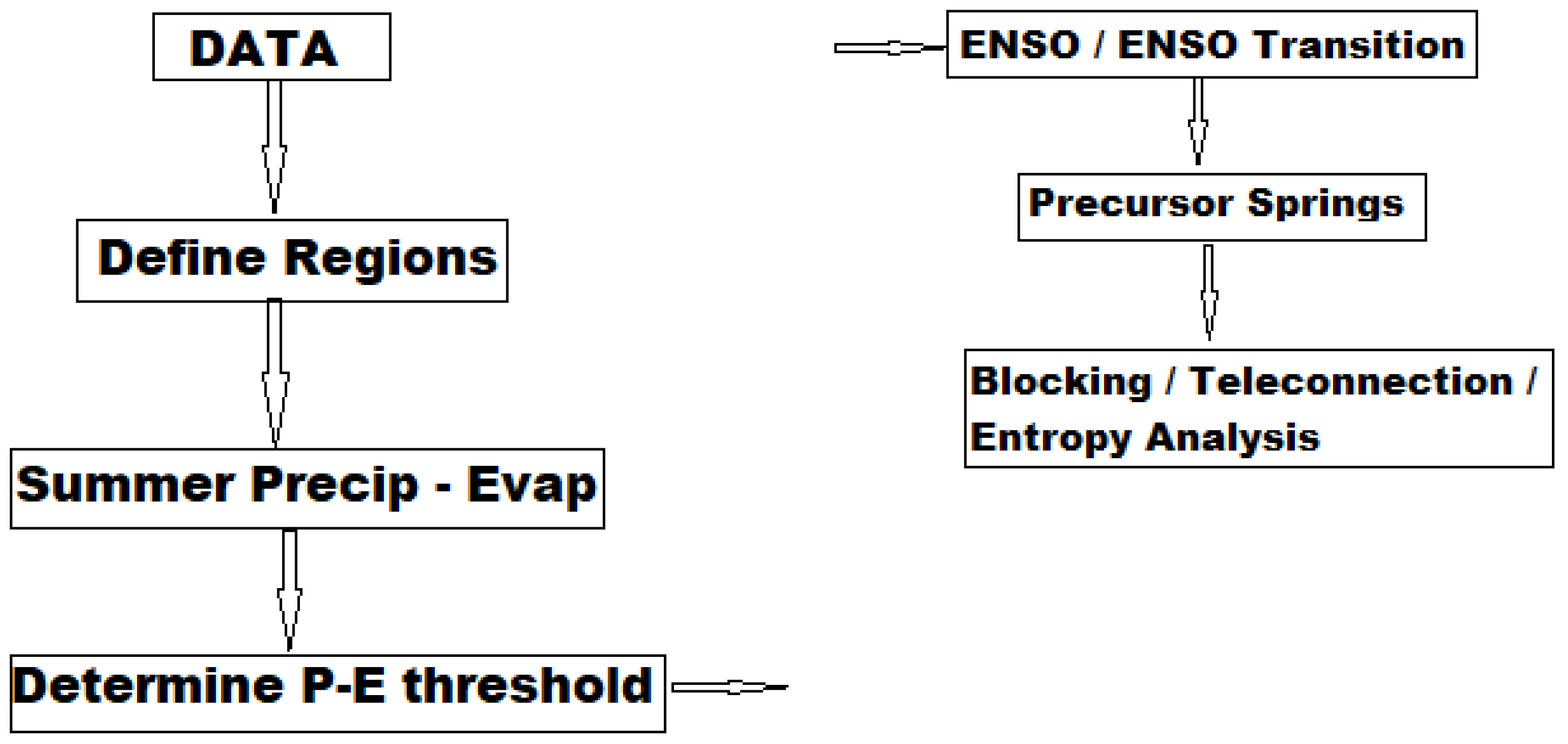
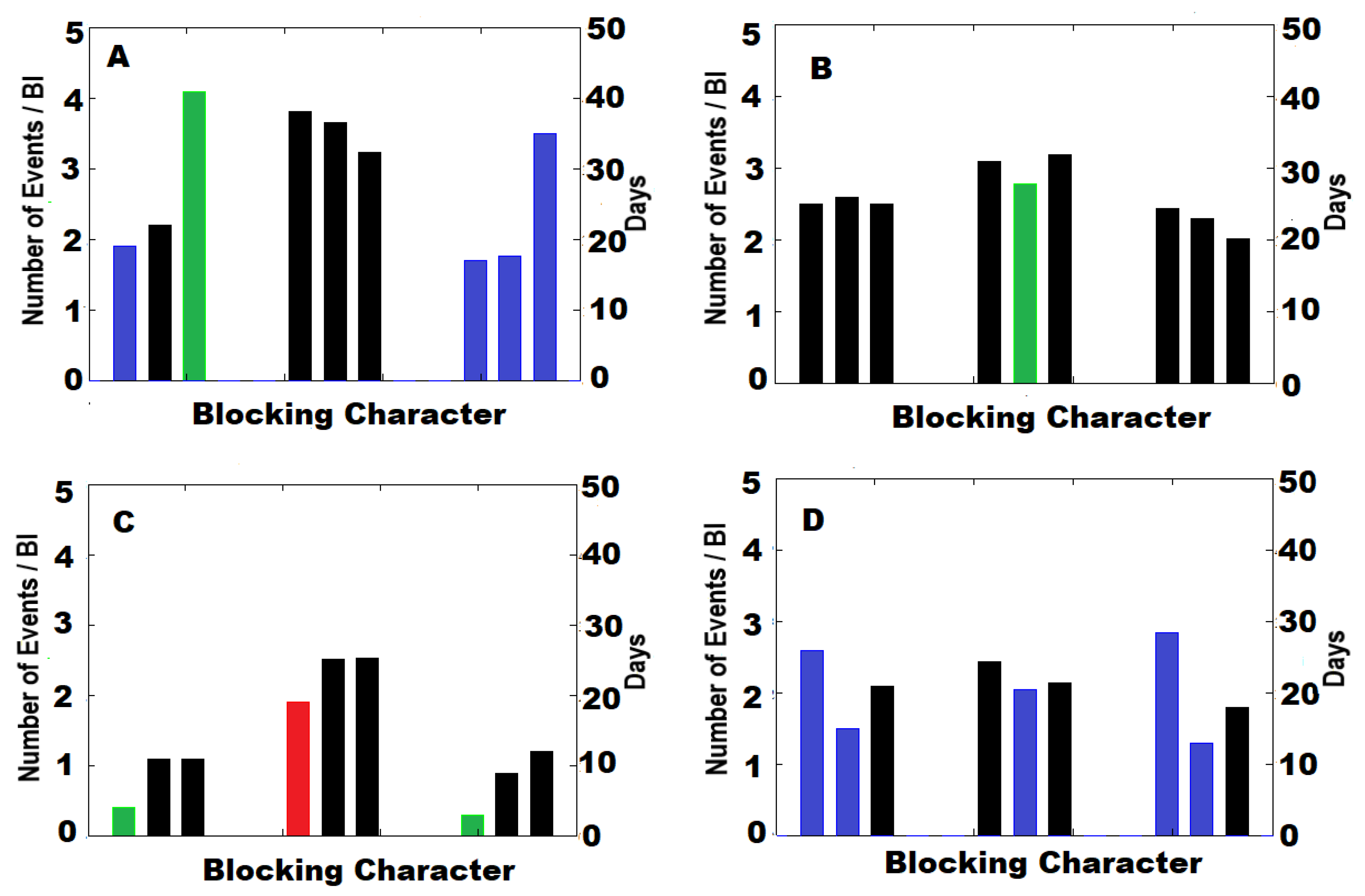


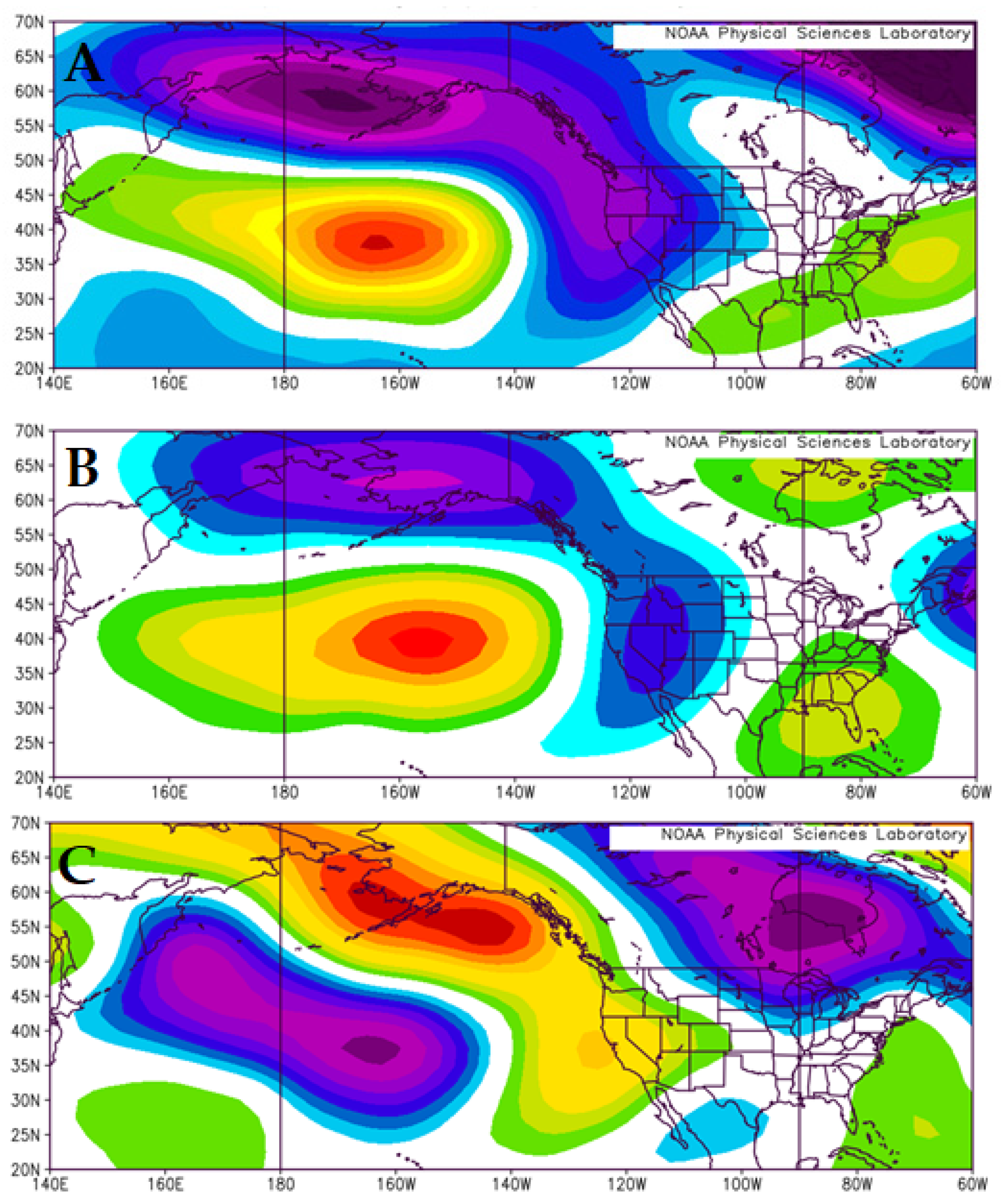
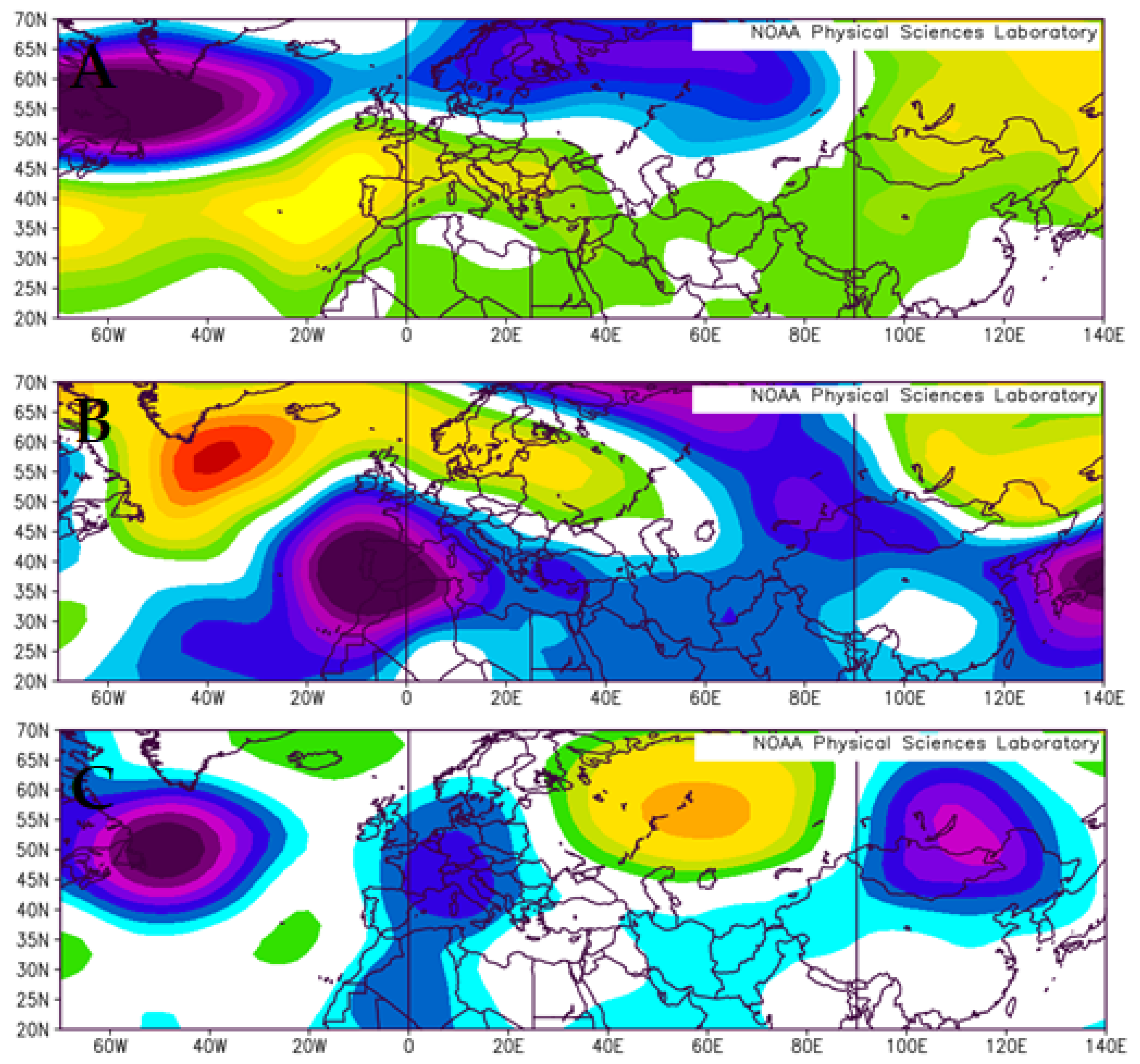
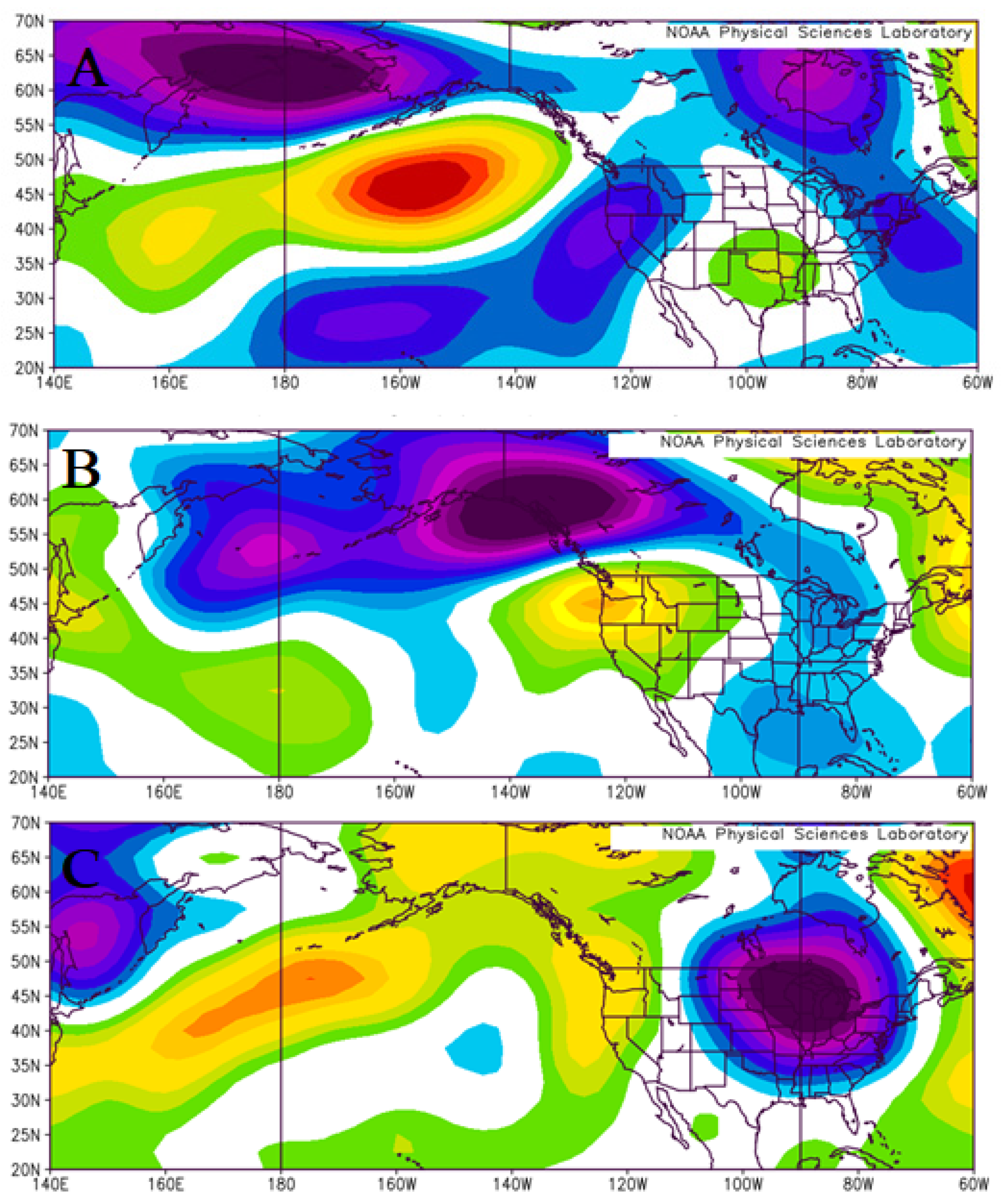
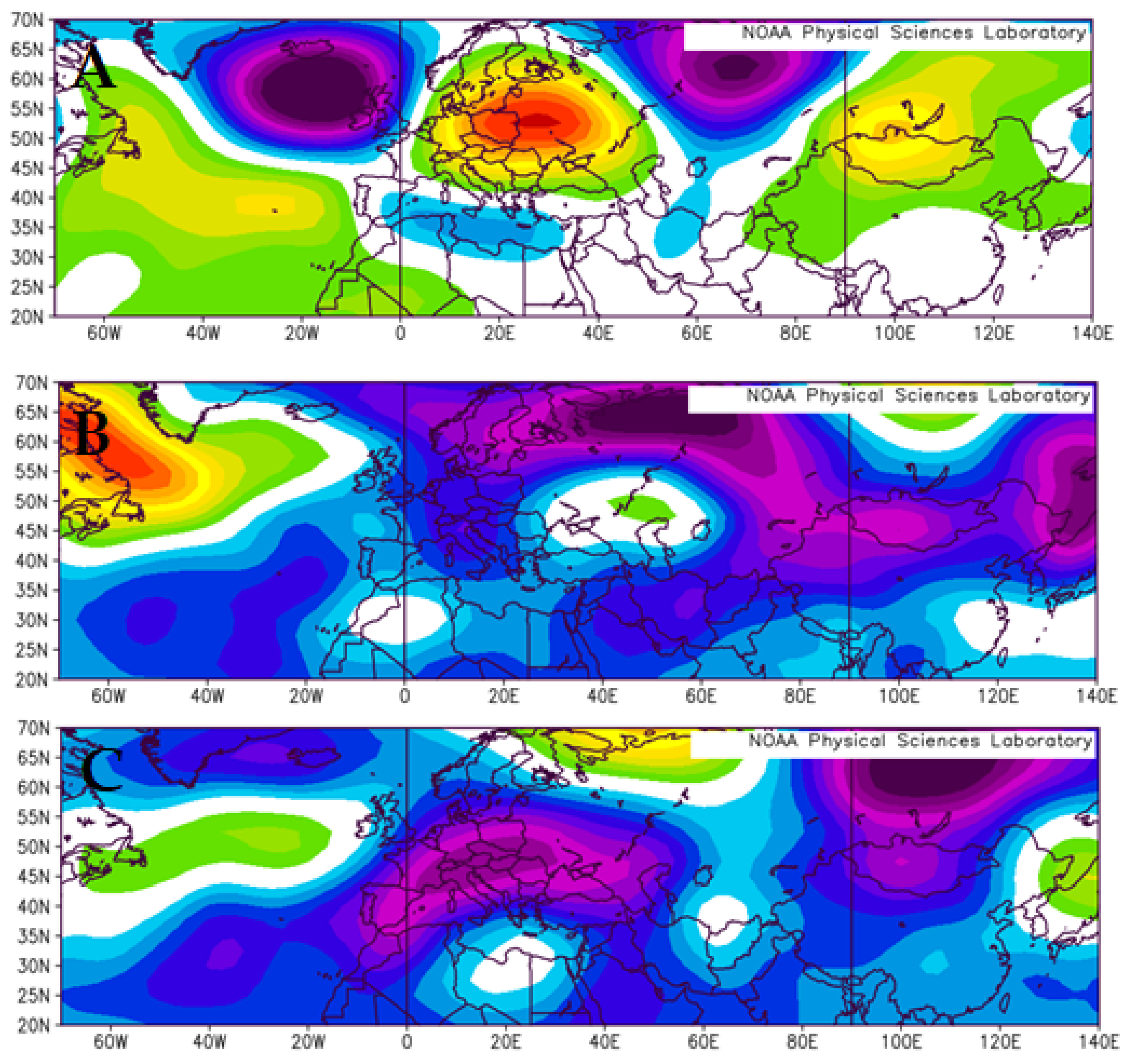
| El Niño (EN) | Neutral (NEU) | La Niña (LN) |
|---|---|---|
| 1969 | 1968 | 1967 |
| 1972 | 1977–1981 | 1970–1971 |
| 1976 | 1983–1985 | 1973–1975 |
| 1982 | 1989–1990 | 1988 |
| 1986–1987 | 1992–1996 | 1998–1999 |
| 1991 | 2000–2001 | 2007 |
| 1997 | 2003–2005 | 2010 |
| 2002 | 2008 | 2017 |
| 2006 | 2011–2013 | 2020 |
| 2009 | 2016 | |
| 2014–2015 | 2019 | |
| 2018 |
| Circulation Group | ECMs Included | Atmospheric Pressure at the North/South Pole | Number of Amplified Waves |
|---|---|---|---|
| Zonal (Type 1) | 1–2 | High | 0 |
| Zonal Breaking (Type 2) | 3–7 | High | 1 |
| Amplified Ridging (Type 3) | 8–12 | High | 2–4 |
| Equatorward Troughs (Type 4) | 13 | Low | 3 or 4 |
| Year | Pre-Evaporation Anomaly | % Area Covered | Col 2 × 3/Rank | ENSO Phase | Transition | Precursor |
|---|---|---|---|---|---|---|
| Extreme | ||||||
| 1972 | −14.5 | 60 | −8.7/2 | LN | LN to EN | Yes |
| 1976 | −9.0 | 90 | −8.1/3 | LN | LN to EN | Yes |
| 1978 | −9.0 | 70 | −6.3/6 | NEU | NEU to NEU | Yes |
| 1980 | −14.0 | 75 | −10.5/1 | NEU | NEU to NEU | Yes |
| 1982 | −10.0 | 25 | −2.5/21 | NEU | NEU to EN | No |
| 1990 | −11.0 | 40 | −4.4/9 | NEU | NEU to NEU | Yes |
| 1998 | −9.0 | 40 | −3.6/14 | EN | EN to LN | Yes |
| 2000 | −10.0 | 75 | −7.5/4 | LN | LN to NEU | Yes |
| 2011 | −13.5 | 30 | −4.1/12 | LN | LN to NEU | Yes |
| 2012 | −9.0 | 30 | −2.7/20 | NEU | NEU to NEU | Yes |
| Moderate | ||||||
| 1970 | −7.0 | 75 | −5.3/7 | EN | EN to LN | Yes |
| 1973 | −7.0 | 60 | −4.2/10 | EN | EN to LN | No |
| 1974 | −8.0 | 85 | −6.8/5 | LN | LN to LN | Yes |
| 1975 | −5.0 | 50 | −2.5/22 | LN | LN to LN | No |
| 1977 | −7.0 | 55 | −3.9/13 | EN | EN to NEU | Yes |
| 1985 | −5.0 | 60 | −3.0/18 | NEU | NEU to NEU | Yes |
| 1988 | −7.0 | 50 | −3.5/15 | EN | EN to LN | Yes |
| 1999 | −6.0 | 70 | −4.2/11 | LN | LN to LN | Yes |
| 2006 | −5.0 | 60 | −3.0/19 | NEU | NEU to EN | Yes |
| 2015 | −7.0 | 50 | −3.5/16 | EN | EN to EN | No |
| 2017 | −5.5 | 60 | −3.3/17 | NEU | NEU to LN | No |
| 2020 | −8.0 | 60 | −4.8/8 | NEU | NEU to LN | No |
| Year | Pre-Evaporation Anomaly | % Area Covered | Col 2 × 3/Rank | ENSO Phase | Transition | Precursor |
|---|---|---|---|---|---|---|
| Extreme | ||||||
| 1972 | −9.0 | 30 | −2.2/12 | LN | LN to EN | No |
| 1992 | −10.0 | 70 | −5.6/4 | EN | EN to NEU | Yes |
| 1994 | −10.0 | 80 | −6.4/3 | NEU | NEU to NEU | Yes |
| 2002 | −10.0 | 70 | −5.6/5 | NEU | NEU to EN | Yes |
| 2008 | −9.0 | 35 | −2.0/14 | LN | LN to NEU | No |
| 2010 | −11.5 | 50 | −4.6/6 | EN | EN to LN | No |
| 2015 | −10.5 | 80 | −6.7/1 | EN | EN to EN | No |
| 2017 | −10.0 | 80 | −6.4/2 | NEU | NEU to LN | Yes |
| Moderate | ||||||
| 1971 | −5.5 | 40 | −1.8/16 | LN | LN to LN | Yes |
| 1975 | −5.5 | 40 | −1.8/15 | LN | LN to LN | Yes |
| 1979 | −5.0 | 50 | −2.2/13 | NEU | NEU to NEU | Yes |
| 1993 | −7.0 | 40 | −2.2/11 | NEU | NEU to NEU | Yes |
| 1996 | −5.0 | 75 | −3.0/8 | NEU | NEU to NEU | Yes |
| 2000 | −8.0 | 40 | −2.6/9 | LN | LN to NEU | No |
| 2009 | −7.0 | 40 | −2.2/14 | NEU | NEU to EN | Yes |
| 2020 | −8.0 | 65 | −4.2/7 | NEU | NEU to LN | Yes |
| Year | ENSO Phase | Transition | Precursor |
|---|---|---|---|
| NA | |||
| 1979 | NEU | NEU to NEU | No |
| 1992 | EN | EN to NEU | No |
| 1996 | NEU | NEU to NEU | No |
| 1997 | NEU | NEU to EN | No |
| 2003 | NEU | NEU to NEU | No |
| 2004 | NEU | NEU to NEU | Yes |
| 2008 | LN | LN to NEU | Yes |
| 2010 | EN | EN to LN | Yes |
| EE/WR | |||
| 1973 | EN | EN to LN | No |
| 1974 | LN | LN to LN | No |
| 1977 | EN | EN to NEU | No |
| 1978 | NEU | NEU to NEU | No |
| 1985 | NEU | NEU to NEU | No |
| 1988 | EN | EN to LN | No |
| 1989 | LN | LN to NEU | No |
| 1995 | NEU | NEU to NEU | Yes |
Publisher’s Note: MDPI stays neutral with regard to jurisdictional claims in published maps and institutional affiliations. |
© 2021 by the authors. Licensee MDPI, Basel, Switzerland. This article is an open access article distributed under the terms and conditions of the Creative Commons Attribution (CC BY) license (https://creativecommons.org/licenses/by/4.0/).
Share and Cite
Lupo, A.R.; Kononova, N.K.; Semenova, I.G.; Lebedeva, M.G. A Comparison of the Characteristics of Drought during the Late 20th and Early 21st Centuries over Eastern Europe, Western Russia and Central North America. Atmosphere 2021, 12, 1033. https://doi.org/10.3390/atmos12081033
Lupo AR, Kononova NK, Semenova IG, Lebedeva MG. A Comparison of the Characteristics of Drought during the Late 20th and Early 21st Centuries over Eastern Europe, Western Russia and Central North America. Atmosphere. 2021; 12(8):1033. https://doi.org/10.3390/atmos12081033
Chicago/Turabian StyleLupo, Anthony R., Nina K. Kononova, Inna G. Semenova, and Maria G. Lebedeva. 2021. "A Comparison of the Characteristics of Drought during the Late 20th and Early 21st Centuries over Eastern Europe, Western Russia and Central North America" Atmosphere 12, no. 8: 1033. https://doi.org/10.3390/atmos12081033
APA StyleLupo, A. R., Kononova, N. K., Semenova, I. G., & Lebedeva, M. G. (2021). A Comparison of the Characteristics of Drought during the Late 20th and Early 21st Centuries over Eastern Europe, Western Russia and Central North America. Atmosphere, 12(8), 1033. https://doi.org/10.3390/atmos12081033







